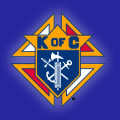Origins
On October 2, 1881, a small group of men met in the basement of St. Mary's Church on Hillhouse Avenue in New Haven, Connecticut. Called together by their parish priest, Father Michael J. McGivney, these men formed a fraternal society that would one day become the world's largest Catholic family fraternal service organization. They sought strength in solidarity, and security through unity of purpose and devotion to a holy cause: they vowed to be defenders of their country and their families and their Faith. These men were bound together by the ideal of Christopher Columbus, the discoverer of the Americas, the one whose hand brought the Holy Faith to this New World. They were Knights of Columbus.
Through the foresight and leadership of Father McGivney, and the sacrifice and dedication of those early Knights, and the millions of their brother who have followed in their footsteps, the Knights of Columbus would become the world's foremost Catholic fraternal benefit society, one that has helped millions of Catholic families grow in their faith and defend their beliefs. It has made its members better husbands, fathers, sons, and citizens. It has helped families obtain economic security and stability through the Knights' life insurance program. It has built Catholic communities, fed the poor and defended the vulnerable. It has helped to renovate the Vatican and bring the Pope to the world.
Continued Growth
Since it was incorporated on March 29, 1882, the Knights of Columbus has grown from several members in one council to more than 12,000 councils and over 1.6 million members throughout the United States, Canada, the Philippines, Mexico, the Dominican Republic, Puerto Rico, Panama, the Bahamas, the Virgin Islands, Guatemala, Guam and Saipan. The Order has had thirteen Supreme Knights, from the first Supreme Knight, James T. Mullen, who designed the famous emblem of the Order, to our current Supreme Knight, Carl A. Anderson, who leads the Order across the threshold of the 21st century. Millions of Catholic men have been Knights of Columbus. Men of all nationalities and backgrounds and professions. Men like baseball great Babe Ruth and President John F. Kennedy.
Love of Church and Country
Charity, unity, fraternity and patriotism. These are the watchwords of the Knights of Columbus. And, since 1882, Knights of Columbus have backed up these words with actions. During World War I, Supreme Knight James A. Flaherty proposed to U.S. President Woodrow Wilson that the Order establish soldiers' welfare centers in the U.S. and abroad. The Order raised more than $14 million for this program on its own, and was allocated another $30 million from a national fund drive.
During the early years of World War II, Canadian Knights set up similar soldiers' welfare centers in Canada. The U.S. Knights were the first national organization to sponsor a blood donor program, and numerous councils led war bond drives in support of the war effort. Thousands of Knights were killed in action during the war.
During the Cold War, Supreme Knight John E. Swift oversaw the Order's varied responses to the Communist threat, as the Knights operated speakers' bureaus, funded anti-Communist advertisements and radio addresses, and published pro-freedom pamphlets. In 1954, the Knights of Columbus led the effort to officially include the words "under God" in the Pledge of Allegiance to the American flag, a crusade that resulted in federal legislation signed by U.S. President Dwight D. Eisenhower.
In 1957, the Knights of Columbus donated a $1 million, 329 foot bell tower to the National Shrine of the Immaculate Conception in Washington, DC, a tower that became known as "the Knights' Tower." The Order has since donated a 56-bell carillon to the Shrine and provided funding for its operation.
During the 1960s and 1970s, decades of degeneration and social chaos, the Knights of Columbus, behind Supreme Knight John McDevitt and Supreme Knight Virgil C. Dechant, stood as a tower amidst societal crisis to promote racial equality and love of country. Against a tide of dissension, the Order championed Church teaching on divorce, birth control, abortion, and pornography.
Since the late 1970s, Supreme Knight Virgil C. Dechant led the Knights to record-breaking growth in all areas of the Order's operations: membership, new council development, international development, insurance sales, volunteerism and charitable giving. He fostered devotion to the Church and the Blessed Mother, and pledged the Knights' support for the Holy Father, the cardinals, bishops and all the clergy and religious. In 2000 the current Supreme Knight Carl A. Anderson was elected to office.
Continuing the tradition of devotion to the Church and the Blessed Mother, he rededicated the Order to its role as "strong right arm of the Church" in the renewal of society. He especially promised new vigor in the fight for the culture of life over the culture of death as the Order moves into the 21st century.
Knights of Columbus have helped to build and support the Catholic Church, from the United States to the Philippines. Knights have lived for their faith in Canada, and died for their faith in Mexico. Throughout the history of the Order, in these and many other ways, Knights of Columbus have provided immeasurable support to their families and communities, to their countries and the Church. The Knights of Columbus has enabled its members to strengthen and protect their loved ones, spiritually, by developing their faith, and financially, with the highest quality life insurance available, a product that has brought security and prosperity to millions of Knights and their families.
Through their dedication to the ideals of the Order, Charity, Unity, Fraternity, Patriotism, and through their fidelity to Christ's Church and his Vicar, the Knights of Columbus continue to be what they were called long ago: "The Strong Right Arm of the Church."
|

